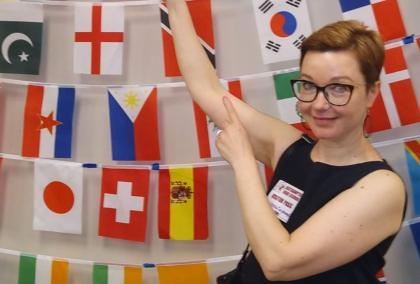Away from coastal areas, the cold months are usually dry, and in the south the thermometer seldom falls below zero Fahrenheit (-18 Celsius). Moreover, Finnish homes and public transportation are very well-insulated and heated.
Daily Wear
For daily wear at university, lecturers normally wear casual suits, sport coats, or even sweaters and ties (skirts and blouses, slacks and sweaters, pantsuits). Student wear is similar to that in the U.S., but graduate grantees should bring some nice options for interviews, dinner invitations, or special occasions.
Formal Wear
You may need formal wear (a dark suit or dress) on occasion, including receptions, the opening ceremonies of the academic year, and invitations to the homes of your university rector or host professor. To wear turtlenecks, sport coats or light-colored suits at such occasions may be considered inappropriate by both the hosts and other guests. It all depends on the situation; it is quite okay, and recommended, to ask your host.
Dress for the Season
As is the case in any country, it is important to dress for the climate. This is especially true in a country like Finland that experiences all of the four seasons in full.
Consider buying/bringing with you:
- Sturdy, insulated walking shoes for fall, winter and early spring
- Raincoat and rubber boots for the rainy period of October-December
- Wool socks (something you might want to buy once you are in Finland)
- Long underwear, woolen tights or long woolen stockings for winter when outside
- Cleats or spikes to wear on your shoes for when the sidewalks and streets are (occasionally) iced over
Clothing in general can be more expensive in Finland. You may want to keep this in mind when planning your clothing needs. You can find some good deals in winter wear at the flea markets and second hand stores, where it is often possible to pick up winter clothes and shoes in new condition at bargain prices. Every city has its own area where locals go bargain-hunting – ask your colleagues and friends.
Dressing in layers is wise. You will often move from well-heated buildings out into the cold and wet and then back again. Headwear is essential in the winter, although if you do not normally wear a hat or cap you could wait to purchase one in Finland so you will have something appropriate for the climate.
A very common and useful practice is to have separate shoes for wearing outside and inside (the office or university, for example) during the colder seasons. Fall and winter shoes are well-insulated, meaning your feet might get hot in them during the day in the office, so bring along another pair of shoes to wear while inside. This is also a good practice for when you have to dress more formal, for the theater for example: bring a pair of dress shoes you can change into once you are inside.
Also, it is good to note that Finns do not wear shoes inside the home. It is customary to take off your shoes when you enter someone's home. Formal events are an exception though; if you are attending a formal event at someone's home, please have clean dress shoes to wear that you can change into when coming inside.
Be prepared to dress warmly for the winter weather. Watch a video by YLE Oulu about how to dress for different weather conditions (link goes to YLE Oulu’s Facebook page).
Hanger loops for jackets
If you bring coats or down jackets from the U.S., make sure they have hanger loops on the inside collar. This is especially necessary for hanging up children’s outerwear at schools or day-care centers.
Every restaurant, school or other coat-check facility will have an attendant who will take your coat and try to hang it by the hanger-loop provided in all coats sold in Finland. Coats without loops soon fall off the peg and may end up on the floor. Dry cleaning bills are considerably more expensive than hanger loop installation!
Children's Clothing
Children dress more or less the same way for school in Finland as they do in the U.S.
Blue jeans are common; these and sweatpants are useful for both boys and girls for playwear. Girls often wear woolen stockings or leggings to school, and kids use ski pants or pants for sports in winter. Long underwear in winter is a must, especially for sports. Finnish snow suits for children are of good quality. Children need book and accessory bags or backpacks, and soft slippers to wear at school or daycare; these can be easily purchased in Finland.
Outerwear is essential. A good fall/spring jacket that is water-repellent and pants of a similar material are a must for small children and school-children who spend their recesses and many class periods outside, no matter the weather. For winter, an insulated ski jacket and ski pants, or an overall for smaller children, are also a must.
In Finland, we live by this rule: "There is no such thing as bad weather, there is only bad clothing".
Remember that children seldom wish to stand out by dressing differently from their peers. Finnish tradition and climate result in the popularity of certain types of clothing and accessories. It is therefore best not to ship extra clothing for your younger children; wait until you are familiar with what their Finnish classmates or playmates are wearing. Perhaps you could arrange for a friend to mail over reserve boxes of extra clothing if the situation warrants, rather than bringing everything with you, only to end up acquiring in Finland most of what your child will actually wear.
Laundry and Dry Cleaning
Bring along as much wash-and-wear clothing as possible. Dressing in layers is advisable rather than lots of thick, woolen garments that require dry cleaning.
Although dry cleaning is easily available, it is considerably more expensive than in the U.S. Easily-dried fabrics are thus preferable. Clothes dryers (either drying cabinets or tumble dryers) are common, but hang-drying is still the rule for many.
Washing clothes takes longer in Finland, in general. Washing machines first take in cold water, then heat the water, then wash the clothes, and then spin after the rinse cycle. European washing machines also have smaller capacities, and they process the fabrics for longer and more thoroughly than most U.S. machines. Many washing machines have a separate option for a short cycle that lasts from 20 to 60 minutes, but those machines that save water could take up to 90 minutes or more to wash one cycle.
When washing a load of laundry by machine, expect it to take longer than in the U.S. Add to this the time required to hang-dry and you are led to certain conclusions about the types of clothing you should bring along, and how long you will spend doing laundry.
Commercial self-service laundry facilities, like laundromats, are becoming more common in Finland. You can usually find them adjacent to hypermarkets, like Prisma or at malls (one such chain is called 24 Pesula).
Student housing and many apartment buildings include laundry facilities, and housing supplied for lecturers and research scholars will often have a washing machine ready. If your housing does not include one, plan on hand-washing your clothing until an alternative can be found.

